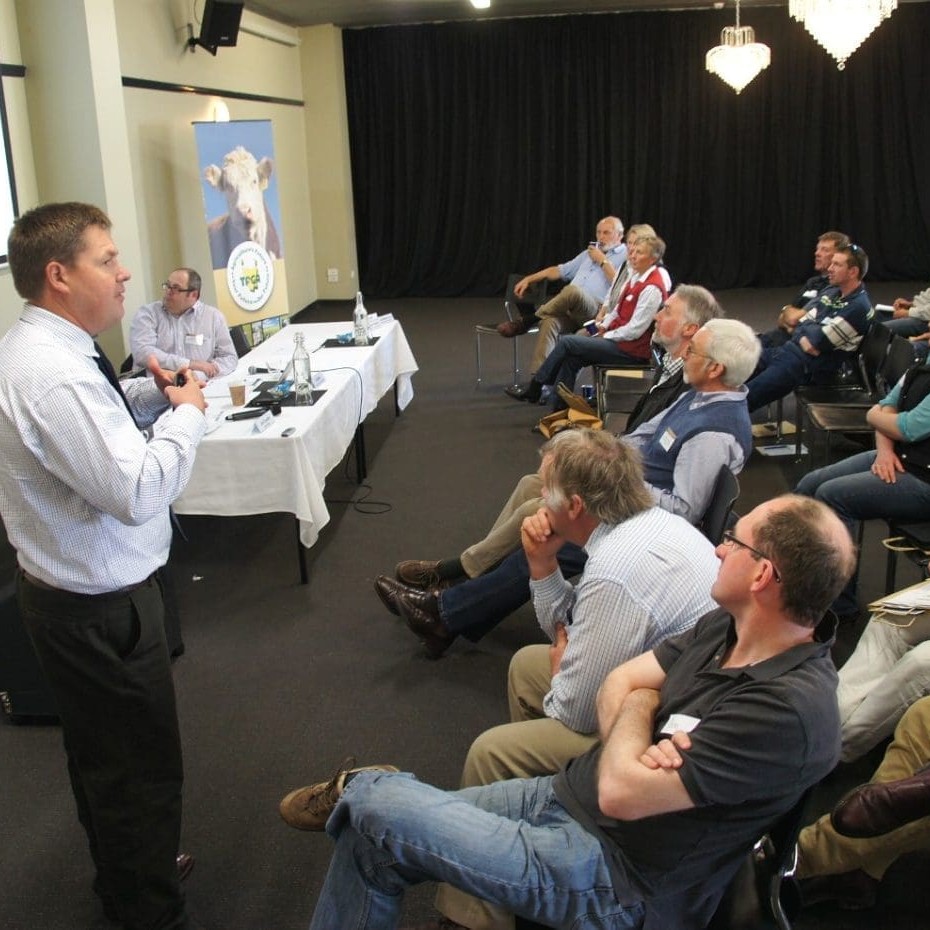NEW objective assessment technologies in various stages of development are showing the potential to change the landscape in the way carcases and even live animals are assessed and valued for meat yield, meat quality and fatness.
 Meat & Livestock Australia’s Dr Alex Ball, program manager for eating quality research and development, gave an outline of some of the new technologies while addressing a Cattle Council of Australia producer forum in Launceston recently.
Meat & Livestock Australia’s Dr Alex Ball, program manager for eating quality research and development, gave an outline of some of the new technologies while addressing a Cattle Council of Australia producer forum in Launceston recently.
The discussion was timely, given CCA’s recent directive to MLA to take a ‘white-paper’ approach to explore the potential to create a new carcase assessment language from the ground up. The move came in response to growing calls for a re-examination of existing carcase quality and yield indicators.
As highlighted on Beef Central earlier, industry stakeholders have been calling for a whole-of-language review – not confined to specific problem areas like butt shape and dentition, but covering the entire spectrum of carcase yield and quality indicators used across kill-floor, chiller assessment and MSA grading.
See some of Beef Central’s earlier articles on the topic here:
- Cattle Council to explore new carcase language
- Butt shape: Is it time for a broader grading/carcase assessment review?
A key aspect of producer concern is the potential that exists under the current AusMeat language for indicators which are seen to be outdated and/or lacking in scientific justification, such as butt profile or dentition, to significantly discount producer returns.
MLA’s Dr Alex Ball outlined to the Launceston producer audience a range of technologies that are coming through the R&D pipeline which appear to have considerable potential to address some of these concerns.
There were some very promising developments in new technologies to describe physical parameters of carcase composition in beef cattle, Dr Ball said.
Some of these involve ‘off the shelf’, and relatively cheap technologies.
The first example involves a group of Sydney university researchers, who had no previous experience within the beef industry, but whose expertise is in the field of new high-definition video image analysis.
“They came to MLA with an interest in applying their technology to see if they could determine the value proposition around beef cattle,” Dr Ball said.
Using a bank of left-side, right-side and stifle cameras, the team is able to walk a live animal through an image catchment area, and predict fat depth in that beast to within 2mm at the P8 and rib site.
“That technology looks really useful, because it could be applied on-farm, in the saleyard, or in lairage at the abattoir,” Dr Ball said.
And what’s providing the ‘grunt’ behind this prototype system, which captures up to three million images per minute?
Anybody who has played with, or seen, an X-Box video game would be familiar with the enormous computing and processing power of the popular gaming consoles.
Surprisingly, the technology used to drive our kids’ video games (in the early trial stages at least – it may change as the project develops) has been found to be ideal for high definition video image analysis.
X-Box units themselves are worth only a few hundred dollars, and the gaming cameras used to capture the images cost only $150 each.
“The trick is in how to bolt these millions of images together and interpret them, but such off-the-shelf technologies can deliver real-time, very accurate measurements of carcase composition. The technology delivers patterns of muscle, patterns of bone and patterns of fat, and in future, it may be able replace the description of fat distribution as a single-point measurement like P8 or rib, with a fat distribution measurement across the whole carcase,” Dr Ball said.
Researchers are setting up a second program using similar technology, capturing about one million images of each carcase, using a camera that ‘spins around’ the body on the rail, creating a three dimensional view. The process takes only 10-15 seconds, meaning it is compatible with chain speeds in large abattoirs.
This technology is currently in trial phase in abattoirs, Dr Ball said, and was already delivering accuracies of 80-90 percent of what was required to deliver ‘proof of concept’ for further commercial development.
More for novelty value than anything else, researchers also hooked-up the technology to latest generation three-dimensional printers, and ‘printed’ an exact scale replica of a carcase in minute detail.
“When you start seeing that sort of technology it’s easy to get excited about the possibilities that lie ahead,” Dr Ball said.
Range of other technologies
Four or five other new technologies were also emerging which could hold considerable potential in objective carcase assessment.
 One example, drawn from the field of human medicine is CAT (computer axial tomography) scanning. This provides a 2D ‘slice’ image of the composition of a 3D object, like a carcase. Trials are already taking place using CAT to provide accurate yield summaries on a beef carcase, based on thousands of ‘slice’ images taken through the carcase.
One example, drawn from the field of human medicine is CAT (computer axial tomography) scanning. This provides a 2D ‘slice’ image of the composition of a 3D object, like a carcase. Trials are already taking place using CAT to provide accurate yield summaries on a beef carcase, based on thousands of ‘slice’ images taken through the carcase.
“The difference between the latest technologies and the industry’s original VIAscan objective video-based carcase assessment system is that where VIAscan was operating at 45-50pc meat yield prediction accuracy, CAT scanning, for example, is already at 85-90pc,” Dr Ball said.
Another CAT-based technology being explored is a walk-through live animal scanner.
A new lamb plant using an auto-cutter system was using a 2D X-ray process to gather a prediction of lean meat yield in every carcase, and using the information to perform the carcase cutting and auto-chining work based on that prediction.
Danish meat probe
Other technologies under examination for in-plant use, look to improve predictions of eating quality – particularly around measurements and intra-muscular fat and WB shear-force (a proxy for tenderness).
A carcase meat probe developed in Denmark, has been shown to deliver measurements of chemical fat, meat colour and pH, in real time, together with distribution of fat.
“When inserted into the muscle, the probe can provide information about distribution of fat. If we can change assessment of intramuscular fat distribution from an AusMeat grading score or a USDA marbling score, to a real measurement of chemical fat, we could probably lift accuracy by another 10pc,” Dr Ball said.
We’ve just trialled the technology in a lamb plant, but it also works well in beef, and the first prototype will be trialled in Australia in early October. The current probe can analyse lamb carcases at the rate of 13 per minute,” he said.
“They have actually analysed the whole carcase and started to give us real time fat measurements through that – it’s quite an exciting piece of technology.”
A local Tasmanian producer attending the forum asked Dr Ball whether this array of new technologies would be prohibitively expensive for smaller processors to install, leaving them at a disadvantage to larger packers.
Dr Ball said the Danish probe, mentioned above, cost just $25,000 per unit.
“Most of the plants in Australian could put that in, because it also saves them a labour unit,” he said.
“At the other end of the scale, at this point CAT scanning in-plant might cost $1.5 million to install, making it applicable only in very large plants. But so long as there is a range of technologies through this suite of tools, the industry is in good shape,” he said.
Another question from the audience asked whether such highly accurate carcase yield calculations could stimulate a move to yield-based payment systems across the beef industry, and potentially, greater selection pressure on beef genetics on meat yield.
“Among the new technologies coming out, I think that within lamb plants, particularly, simply because of scale, we will see accurate lean meat predictions on each carcase, and potentially feedback of that information to livestock producers, within 12 months,” Dr Ball said.
“If the new camera system discussed above passes the proof-of-concept stage, there are already several beef processors very interested in installation. That might take two years to complete,” he said.
When researchers set up the lamb version, they found a minor (0.7) correlation between selection for lean meat yield and eating quality. The more an animal is selected for LMY, the more negative impact is seen on eating quality.
“We know beef’s correlation is less, at about 50pc (0.5), but if we can put together accurate measurements for both eating quality and yield, the industry could be in for an exciting new quantum shift, and I hope I’m part of it in the next couple of years,” Dr Ball said.



HAVE YOUR SAY